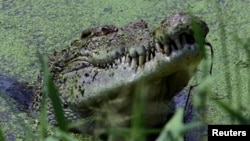DARWIN —
As the crocodile population reaches levels not seen since hunting was banned in Australia’s Northern Territory in the early 1970s, wildlife authorities are reinforcing efforts to protect residents and tourists. School children are taking part in a new “Crocwise” campaign following several fatal attacks in recent years and other near-misses. It is estimated there are 130,000 saltwater crocodiles in northern Australia.
The message to schoolchildren in Darwin is simple: that one of nature’s most efficient killers lives among them.
Rachel Pearce, from the Parks and Wildlife Commission of the Northern Territory, told schoolchildren in Darwin of the dangers posed by the world’s largest reptile. She showed them a crocodile’s skull, where rows of sharp teeth are embedded.
Pearce said that as crocodile numbers increase, so does the threat to residents and visitors.
“There are crocodiles in people’s backyards. We get call-outs to them walking into people’s lounge rooms," she said. "Lots of people here live on creeks. They have big, open houses. When the rivers rise, the crocs are able to go wherever they like and quite often they’ll walk up into people’s backyards looking for their dogs or different things, so they are in very close proximity with people here.”
Crocodylus Park in Darwin is home to thousands of these armored-plated and supremely aggressive reptiles. It is one of Australia’s leading crocodile research institutions.
“Large animals have been known to puncture an aluminum boat - put their teeth through the hull,” explains Charlie Manolis, chief scientist at the park.
TV advertisements warn of the ever-present dangers, as northern Australia learns to live alongside one of nature’s most fearsome predators.
The authorities have set up a 50 kilometer crocodile-free exclusion zone around heavily populated areas of Darwin and its busy harbor. Traps catch hundreds of reptiles each year. The animals are sold to crocodile farms, which produce meat and souvenirs, including belts and handbags made from reptile skins.
The number of attacks is increasing in northern Australia. Most victims are not tourists who ignore the warnings and stumble into trouble, but complacent locals. For many, the waterhole or creek they have swum in since they were children is now out of bounds as the crocodiles spread.
There is, on average, about one fatal crocodile attack each year.
Crocodiles are found in the tropics in Africa, Asia, the Americas and Australia.
The message to schoolchildren in Darwin is simple: that one of nature’s most efficient killers lives among them.
Rachel Pearce, from the Parks and Wildlife Commission of the Northern Territory, told schoolchildren in Darwin of the dangers posed by the world’s largest reptile. She showed them a crocodile’s skull, where rows of sharp teeth are embedded.
Pearce said that as crocodile numbers increase, so does the threat to residents and visitors.
“There are crocodiles in people’s backyards. We get call-outs to them walking into people’s lounge rooms," she said. "Lots of people here live on creeks. They have big, open houses. When the rivers rise, the crocs are able to go wherever they like and quite often they’ll walk up into people’s backyards looking for their dogs or different things, so they are in very close proximity with people here.”
Crocodylus Park in Darwin is home to thousands of these armored-plated and supremely aggressive reptiles. It is one of Australia’s leading crocodile research institutions.
“Large animals have been known to puncture an aluminum boat - put their teeth through the hull,” explains Charlie Manolis, chief scientist at the park.
TV advertisements warn of the ever-present dangers, as northern Australia learns to live alongside one of nature’s most fearsome predators.
The authorities have set up a 50 kilometer crocodile-free exclusion zone around heavily populated areas of Darwin and its busy harbor. Traps catch hundreds of reptiles each year. The animals are sold to crocodile farms, which produce meat and souvenirs, including belts and handbags made from reptile skins.
The number of attacks is increasing in northern Australia. Most victims are not tourists who ignore the warnings and stumble into trouble, but complacent locals. For many, the waterhole or creek they have swum in since they were children is now out of bounds as the crocodiles spread.
There is, on average, about one fatal crocodile attack each year.
Crocodiles are found in the tropics in Africa, Asia, the Americas and Australia.





